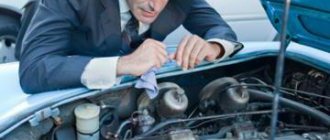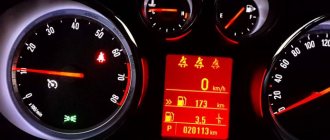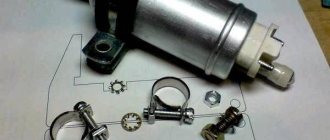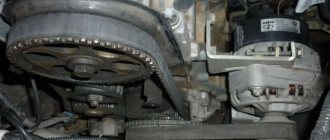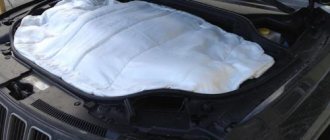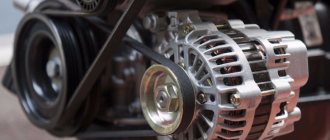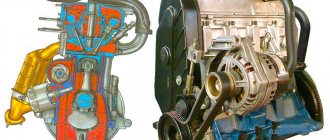A little about the car
Among the advantages of this model are simplicity and reliability, which was noted by many Hyundai owners.
However, despite the positive assessment of the majority of car enthusiasts, the car can completely suddenly let the driver down. The problem will arise if the car stalls while driving, or the car stops starting altogether. Also, many car enthusiasts noted problems with the engine after starting the vehicle. What could be the reasons for possible breakdowns and how can they be dealt with?
Diagnosis and troubleshooting in situations where the starter turns the engine
The standard Hyundai Solaris operating manual contains step-by-step instructions that provide a complete algorithm of actions for all possible types of malfunctions.
Let's start with the most common: the crankshaft rotates slowly or the starter does not turn the engine. These symptoms are typical for Hyundai Solaris with automatic transmission. Most often, simple steps will help: you need to move the gear lever to neutral or park. You may have to repeat the move several times - this usually resolves the problem.
One of the common reasons for the inability to start the engine is the complete or partial, to a critical level, discharge of the battery. Having become accustomed to the flawless and flawless operation of the vehicle, many drivers forget about this. How to determine whether the battery charge level is sufficient to start the engine?
- First of all, you need to check the battery terminals.
- Next, visually inspect the wires going to the starter: they should not have any signs of breakage and should be firmly connected to the terminals.
- If there are no comments on two points, then turning on the light in the cabin will allow you to determine whether the battery needs charging. Dim lighting or turning off of the lights when you try to start the engine indicates a low battery.
- You need to charge the battery or try to “light” the car from another vehicle.
If these steps do not solve the problem, you should pay attention to the immobilizer.
An immobilizer is a security device that allows you to identify the owner and start the car only if the digital code in the key chip completely matches the data of the device itself. When the lamp lights up, the immobilizer signals that it does not see the key.
There are several options for troubleshooting on site:
- Make several attempts to remove and insert the key - usually this method takes at least half an hour and gives a 100% guarantee of a positive outcome and starting the engine.
- You can try to gain access to the engine using a duplicate key or its exact copy (usually included in the kit). If the engine was able to start the first time, then the reason is a faulty permanent key.
- The immobilizer antenna may be faulty - it has failed due to wear or oxidation of the contacts. In this case, the signal that the key is genuine simply does not reach the ECU. Therefore, there are not many options - move the ignition switch or use WD-40 liquid to clean the contacts.
If none of these actions help, you need to call a tow truck and transport the Hyundai Solaris to a specialized center for diagnostics. For owners, this can result in unforeseen expenses: from replacing the immobilizer antenna or flashing it to purchasing a new computer or a special device - an immobilizer bypasser.
Additionally, the cause of the malfunction may be:
- Faulty starter;
- Worn starter (armature) brushes;
- Interturn short circuit of the windings or a break in the windings of the electric starter relay;
- Interturn short circuit in the electric starter windings;
- Blocking of the electric starter due to the installation of an abnormal alarm system;
- Malfunction of the ignition switch contact group;
- For vehicles equipped with an automatic transmission, the selector is defective or broken.
More on the topic: Hyundai Solaris equipment: technical characteristics
These defects and breakdowns relate to complex cases, and it will not be possible to deal with them on the spot - you need tools, a lift or an inspection hole. Therefore, the vehicle must be delivered to a specialized service center for diagnostics.
The standard user instructions suggest a series of sequential actions if the crankshaft turns, but the engine does not start.
- Checking the fuel level;
- Diagnostics of electrical circuits and terminal connections;
- Coil diagnostics;
- Checking the spark plugs;
- Checking the fuel line;
- Attempt to start the engine.
In fact, it’s worth starting with checking the spark plugs: the Hyundai Solaris has four ignition coils, so there’s no need to check them - the probability of simultaneous failure is negligible, and it’s possible to diagnose a breakdown at an earlier stage - it is expressed in the “triple” of the engine, burning indicator on the dashboard and dips when pressing the accelerator. Therefore it is necessary
- The candles are wet. This indicates that the fuel line is working properly, so we change the spark plugs.
- The candles are dry. In this case, the fuel pump may be faulty or not supplying the required pressure, or the fuel filter may be clogged. Replacing the fuel filter can solve the problem in most cases. You can also check the cleanliness of the air filter - perhaps the engine does not have enough air.
If all the emergency measures and manipulations taken did not help, and the engine still does not start, you can check the sensors and valves, replace the fuel pump, and check the wiring. Each procedure is quite time-consuming and requires special equipment and tools.
Conclusion
Grinding and crackling noises in the power unit indicate that some engine parts have failed. So, the grinding noise is accompanied by a malfunction in the starter or flywheel. As for the crackling sound, the situation is much more complicated - most likely the problem is hidden in the crank mechanism or in the cylinder head.
Even an inexperienced car enthusiast will say that the main unit in any vehicle is the internal combustion engine. If a malfunction occurs in the operation of this unit, the driver will know about it immediately by the behavior of the car. One of the common problems in engine operation is the appearance of extraneous sounds. Why you hear a whistle and what to do in this case - this material will help you understand the problem in detail.
[Hide]
What to do if the starter does not turn
The first reason for a possible breakdown may be that the starter does not turn. This situation is provided for in the vehicle operating manual. The document states what the cause of the malfunction may be, and also provides step-by-step instructions on how to fix the problem.
One of the most common reasons for the inability to start the engine is slow rotation of the crankshaft. This is especially true for cars using an automatic transmission. In this case, the gear shift lever should be moved to neutral. The car may not start the first time, and the action will have to be repeated.
Another reason could be that the battery is low. Most drivers miss this point, getting used to the flawless operation of the car.
In addition, very often this problem occurs in cold weather. There are several ways to determine whether there is enough charge to start the engine:
- First, you should check the battery terminals.
- Then it is recommended to inspect the wires connected to the starter. They should not show any damage in the form of signs of tearing. The connection point should also be tight.
- If both points above do not arouse any suspicion, you should turn on the light in the car. If the lighting is dim, the battery charge is low.
To prevent the car from stalling during the next attempt to start it or while the vehicle is moving on the road, it is recommended to recharge the battery. Otherwise, the starter clicks until it finally stops working.
Also among the reasons for the impossibility of starting the engine in this situation are:
- immobilizer malfunction;
- faulty starter;
- possible short circuit of the windings;
- system blocking;
- faulty wires at the point of contact with the ignition switch.
More on the topic: Engine life of Hyundai Solaris 1.4, 1.6
The last listed points relate to complex cases, so to solve such a problem you should visit a car dealership, where specialists will correct the defects that have arisen.
When I try to start the car I hear a crashing sound
When you turn the ignition key to the starter mode, a cracking sound is heard, but the car does not start.
One of the reasons why the starter clicks but does not turn is a severely discharged battery.
This can be easily diagnosed with a regular multimeter. Normal voltage at the battery terminals should be approximately 12.5 V.
When you turn the key, current begins to flow from the battery positive through the ignition switch to the starter relay, and then to the starter solenoid relay coil. The starter should turn on.
But if the ground on the contacts is broken or the contacts are oxidized or damaged, then the starter will turn off due to lack of voltage.
But since the voltage remains connected, the cycle will repeat again.
This is how the starter clicks under the hood occur.
To establish the reason why the starter clicks but does not turn the engine, you need to sequentially check the ground in the circuit from the battery to the starter with a multimeter.
You can try to find the location of the wire damage and fix the problem.
The starter turns, but the engine does not start
Another standard situation is when the crankshaft turns, but the car does not start. Here you should perform the following sequence of actions:
- Check the gasoline level.
- Assess the condition of electrical circuits and wires.
- Conduct coil diagnostics.
Finally, you should make one more attempt to start the engine. Often the problem lies in the breakdown of the spark plugs. There is no need to check the coils, since the car has enough of them, and a simultaneous breakdown of all coils at once is practically excluded.
Thus, when checking candles, you can consider two possible cases and their solutions.
| Condition of the candles | Solution |
| Candles are wet | This means that the fuel line is fine. Then the usual replacement of spark plugs is performed. |
| Dry candles | This indicates a faulty fuel line, which is pretty bad. Regularly replacing spark plugs will not help, so it is recommended to replace the entire fuel filter and also check the cleanliness of the air filter. |
Basically, such actions can solve the problem and start the Hyundai Solaris engine. However, if all else fails, it is recommended to seek help from qualified professionals.
Diagnostics, replacement and repair of DBP sensor and thermometer
On Hyundai Solaris, these two sensors can only function in conjunction with each other. Usually, for emergency troubleshooting, it is enough to swap these two sensors - this will allow you to quickly start the engine, provided that both elements are in good working order.
However, if there is a breakdown in the DBP, you will not be able to start the engine. Reasons for DBP failure:
- Air leakage due to the gap between the element and the inlet fitting;
- Pipeline contamination;
- Failure of the temperature sensor;
- Breakage of internal wires or breakdown of a semiconductor;
- The wire connection is broken.
, so it is necessary to replace this element. Standard DBP diagnostics are carried out with the engine idling. In conditions where you need to drive “right now” and the engine is not running, this will not be possible.
Sometimes it happens that the engine does not start due to sensor failure. Usually, to urgently fix a breakdown, you can use the advice of changing the places of two devices, if both are working.
However, if there is a breakdown in any of the sensors, you will not be able to start the car. Among the reasons causing the device to malfunction are:
- Penetration of air into the gaps between the elements and the fitting.
- Dirt getting into the pipeline.
- Failure of one of the existing sensors.
- Deformation or rupture of wires, leading to failure of the entire system.
The picture shows the idle air control on the Hyundai Solaris (IAC).
Sensor failure in this list is considered the main cause of the malfunction. In this case, it is necessary to replace this element as soon as possible. Diagnostics can be carried out independently with the engine idling. However, you won’t be able to replace the element yourself; therefore, you will still have to visit a service center.
Causes of extraneous sounds in the engine compartment during or immediately after starting the engine
If you hear a whistle and other extraneous sounds when starting the engine, this may indicate various problems associated with its operation. As a rule, these sounds are not so much dangerous for the unit as they are annoying to the driver himself. However, if squeaking, clicking, or knocking noises from the engine occur, the problem must be addressed immediately.
Belts
So, if a whistle appears when starting the engine, then one of the most common causes of this problem is belts. The squealing noise may be due to wear on a particular belt or poor tension, and it may become louder as the crankshaft speed increases. But sometimes when you press the gas, the whistle may disappear altogether. If you hear a whistle when trying to start the engine, then first of all you need to check the tension of all drive belts.
If during the diagnostics you notice that one of the belts is loose, this in turn can lead to its slipping, which can lead to the appearance of sounds uncharacteristic of engine operation. In this case, tightening the strap can solve the problem. Remember that slipping can also be caused by dirt and engine fluid that gets on the straps. If this is the case, then the cause of the oil leak must be solved before replacing the belt; of course, you can try to clean it, but experts recommend changing them anyway (the author of the video is the channel In Sandro’s Garage).
As practice shows, most often ringing and squeaking when starting the engine is caused by the alternator belt, and extraneous sounds disappear after increasing the engine speed. This problem is fraught with insufficient battery charge, which, in turn, can lead to multiple consequences. Moreover, if the belt breaks, the battery simply will not be able to charge while the engine is running. As a result, a corresponding low battery indicator may appear on the dashboard; if this happens, you need to check the condition of the belt itself.
In some cases, the problem may be with the timing belt, and the consequences of such a malfunction will be more serious. The appearance of extraneous sounds may be due to wear of the bearings. If the strap itself breaks for some reason, this can cause the valves to bend, and such repairs, in turn, require large financial costs. Check the condition of the belt itself - there should be no signs of damage, peeling or cracks. If they are present, the strap must be replaced.
Rollers and bearings
The appearance of unpleasant rattles, pops and other third-party noises can occur due to the fault of bearing devices, as well as rollers. The engine design uses more than one bearing and roller, so it can be difficult to find the cause. From a normal whistle, the sound when rollers and bearings wear out will be lower; as a rule, it appears when the engine is running at idle speed. Moreover, when they increase, it will either disappear completely or be quieter. Worn rollers with bearings must be replaced before a more serious problem occurs (video author - IB Channel).
Intake system malfunctions
Grinding and popping noises, as well as crackling noises when starting the engine, sometimes occur due to malfunctions in the operation of the intake system. Of course, you should move on to this option when you are sure that the bearings, rollers and belts are working properly.
So, what malfunctions are typical for the intake system:
- Throttle valve. This unit sometimes jams, as a result of which it creates specific turbulence in the air flow. If the appearance of grinding and popping noises, as well as whistling, is caused by this particular problem, the damper must be completely flushed. Please note that to most effectively clean the unit, it will need to be completely dismantled.
- The reason may also be the intake valve, which is responsible for the circulation of crankcase gases. If it becomes clogged, it will prevent normal circulation of hot air; therefore, due to very high pressure, engine fluid may be squeezed out of the seals. To get rid of such a malfunction, the valve will need to be cleaned, but to do this it must first be removed. Depending on the design features of the engine, it can be located either on the crankcase ventilation pipe or on the valve cover. If the valve itself is made of metal, any substances that will not scratch the surface can be used for cleaning. If the device is made of plastic, then it is better not to use aggressive agents.
Turbine malfunctions
Most modern cars are equipped with turbochargers, the purpose of which is to increase engine power, as well as improve the driving characteristics of the car as a whole. However, it is another powertrain component that can cause knocking, grinding, and popping noises. If the engine starts and a knocking and grinding noise is heard, then there is a possibility that this problem is caused by an air leak in the place where the turbocharger and the power unit connect. As a rule, the appearance of sounds uncharacteristic of internal combustion engine operation indicates a failure of the turbocharger. This malfunction is more typical for diesel units (the author of the video is the MZTk Turbocom channel).
Starter
If you clearly hear a grinding noise, then there can only be one cause of the malfunction - the bendix, which is one of the main elements of the starter, for some reason cannot engage with the flywheel. The grinding noise itself appears as a result of skipping teeth. It should be noted that such a breakdown must be eliminated as quickly as possible, otherwise there is a possibility of damage to the gears of both the flywheel and the starter unit.
The following elements are subject to diagnosis:
- First of all, you should diagnose the mounting of the device - in practice, due to driving on uneven roads, the bolts that secure it may become unscrewed. This leads to the fact that the mechanism will be skewed, accordingly, the gear will lose contact with the flywheel. You need to dismantle the starter assembly and diagnose the condition of the bendix.
- If the problem lies in gear wear, then the efficiency of the mechanism will be significantly reduced. The grinding noise itself will appear as a result of the bendix bypassing, and if you do not deal with this problem as quickly as possible, the starter device may eventually stop turning the flywheel altogether. After dismantling, if the gear is really worn out, you will be able to see it without the help of specialists.
- There is a possibility that the bendix does not move well along the shaft and is not able to reach the flywheel. Try to dismantle it, and lubricate the shaft itself with engine fluid, then reinstall it and re-check the operation of the unit. It would not be superfluous to carry out diagnostics of the traction relay.
Photo gallery “Worn starter elements”
Diagnostics, catalytic converter valve replacement
– a container with activated carbon or other substance that acts as a neutralizer and traps fuel vapors, preventing them from entering the atmosphere.
The canister valve is mounted between the intake manifold and the canister, providing ventilation. Intensive use of the vehicle leads to breakdown of the purge valve, and this, in turn, damages the fuel pump and makes it impossible to start the engine. The opening/closing of the valve is controlled by the ECU.
You can check it using the error diagnostic system - the codes are stored in the controller’s memory.
More on the topic: Tires for Hyundai Solaris: how to choose, sizes, pressure
This valve is designed to provide ventilation in the system, and failure of the element leads to serious damage to the vehicle. As a result, if a malfunction occurs in the adsorber, the car engine will not be able to start.
Valve operation is checked using an error diagnostic system. If a problem is detected, specialist help is required.
Replacing coils and wires
Finally, the last reason for the engine failure to start on a Hyundai Solaris is defects in the wires and malfunction of the coils, which occurs least often. In this case, the check must be performed as follows:
- Remove the plastic cover;
- Pull the coil out of the valve where the spark plug is located;
- Connect it to the spare spark plug;
- For a few moments, lean both elements against ground and at the same time “click” the starter.
If a spark does not appear on the spark plug, it means that one of the coils is broken, since in the absence of malfunctions the spark plug begins to burn. You can also evaluate the performance of the coil visually by inspecting it for damage. A faulty part will be indicated by small spots on the body, as well as melting or broken insulation.
This is the main list of possible reasons why the Hyundai Solaris stops starting. Sometimes a few steps are enough to fix the problem. However, sometimes you need the help of real professionals who are able to perform not only high-quality diagnostics, but also replace parts, if necessary.
If it turns out that you cannot cope with the problem yourself, it is recommended to give up trying to solve it and call a tow truck, which will deliver the car to the nearest service station.
The standard method of checking the serviceability of the wiring involves the presence of sparks on the spark plug: you need to remove the plastic cover, remove the coil from the spark plug channel, connect it to a spare spark plug and lean it against ground for a few seconds with the starter turned on.
If there is no spark or weak sparking, a breakdown of one of the coils can be assumed. Visual diagnostics will show the presence of melts on the coil or small spots on the plastic body. In this case, you can replace the element with broken insulation.
However, the lack of power to the ECU can only be diagnosed with special equipment (in this case, none of the coils work, so the internal combustion engine will not start).
This is the main list of faults that may cause the Hyundai Solaris engine to fail to start. Usually, checking the underlying causes is enough to quickly fix the problem and start the car. If it is impossible to start it yourself, the manufacturer does not recommend pushing or pulling the vehicle - to avoid damage to expensive important components and assemblies of the vehicle, you should order a tow truck.
More about Solaris
- Buy Solaris Hyundai - prices in Moscow from an official dealer, new Hyundai Solaris
- Price and equipment Hyundai Solaris
- Prices and configurations of the Hyundai Solaris 2019-2020, the cost of the new Hyundai Solaris in Moscow from an official dealer
- Hyundai Solaris 2020: “Comfort” package [price, photo, video, what’s included]
- Hyundai Solaris configurations: technical specifications
- Replacing power steering fluid Hyundai Solaris
- Test drive of the new Hyundai Solaris. Second sun
- How serious are the problems of the Hyundai Solaris?
- What to do if Hyundai Solaris won’t start: repairs, photos, videos
- How serious are the problems of the Hyundai Solaris?
Starter
There are several reasons for this behavior. In order to understand the reasons in more detail, you need to know the starter design and operating principle. It consists of an electric motor, on the shaft of which an overrunning clutch with a drive gear is installed. In everyday life, the clutch and gear are called bendix. The design also includes a starting relay with a solenoid. This design is called a “traction relay”. It is connected to the clutch by the starter activation lever. This design works as follows
. When turned on, the electric motor begins to rotate the bendix. At the same time, the traction relay, having activated, moves the overrunning clutch forward using a lever. As a result, the gear meshes with the teeth of the flywheel and spins the engine. After the engine starts, the overrunning clutch is activated. This protects the starter from damage. When the power supply to the device is turned off, the relay stops working and the starter bendix returns to its original position. Passenger car starters usually use a roller-type overrunning clutch.
There is only one reason for the grinding noise at startup. For some reason the Bendix cannot fully engage the flywheel. Therefore, when starting the starter, a grinding sound of skipping teeth occurs. This problem needs to be fixed as quickly as possible. Otherwise, the flywheel and starter gears may be damaged. You need to check the following points:
- First, check the starter mounting. Sometimes vibration can cause the mounting bolts to come loose. In this case, the starter becomes warped and the gear loses full contact with the flywheel. In any case, remove the starter and check the condition of the bendix;
- Sometimes the problem can be caused by gear wear. In this case, the starter's performance decreases. When starting the engine, you will hear the grinding sound of the bendix moving around. Over time, the starter will not be able to turn the flywheel at all. After removing the part from the machine, you can see the gear wear with the naked eye;
- Sometimes the Bendix does not move well along the shaft and simply does not reach the flywheel. In this case, remove it. You need to coat the shaft with any motor oil (5w30 or 5w40 or whatever you have on hand). Also check the operation of the traction relay.
there is a problem somewhere in the starter
A crackling sound when starting can also occur due to problems with the starter's power supply. It appears when the positive wire is loosened. If there is poor contact, a spark discharge occurs, which is what produces a crackling sound. Check the wire. Tighten it if necessary. Flywheel
. The cause of the grinding noise may be in the engine. If the flywheel teeth are worn too much, they cannot form full contact with the starter gear. As a result, you can hear an unpleasant grinding noise. It is advisable to replace the flywheel. Otherwise, the wear of the bendix will increase and you will have to change it regularly. Since we are talking about the flywheel, read our two materials on this topic:
- “Pros and cons of a lightweight flywheel”;
- “Independent replacement of a dual-mass flywheel with a single-mass one.”
Roller mounting bolt (timing) Conclusion
